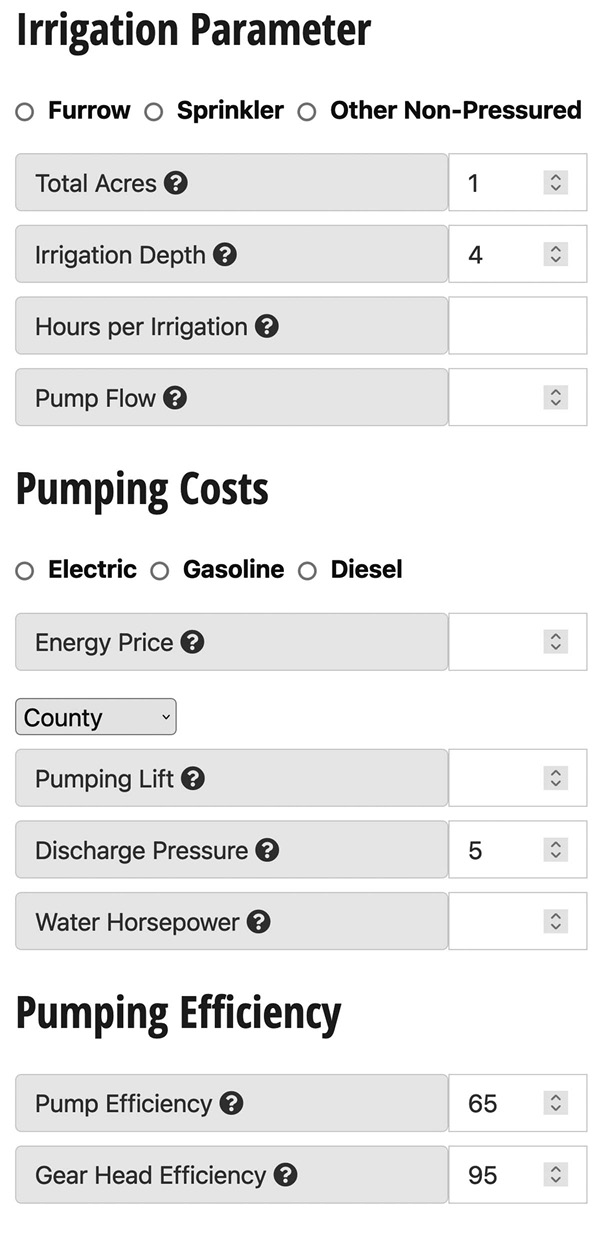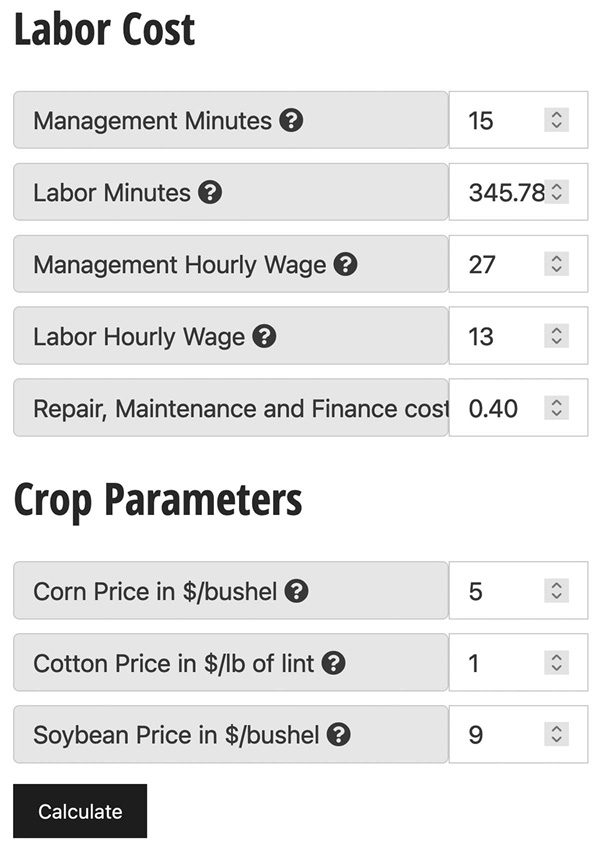How to Calculate Irrigation Pumping Costs with MITOOL
Being informed on the cost to irrigate can enable you to save time and money as you make irrigation termination decisions. Mississippi State University’s Mississippi Irrigation Termination Optimization On-Line (MITOOL) app helps you estimate the cost to irrigate. This checklist will guide you using the MITOOL.
Follow These 14 Steps to Calculate Your Irrigation Costs and Break-Even Yield
Consider this: Hover over or click the question mark icon in the tool to learn more about each parameter.
1. Select Irrigation Type
Select the irrigation type. This aids the calculator in determining the dynamic head.
2. Enter Acreage
Enter the acreage of the field where irrigation is being considered.
3. Enter Flow and Irrigation Depth or Hours per Irrigation
Pump flow, irrigation depth, and hours per irrigation are dependent on each other. Start by entering flow in gallons per minute. Then, either enter the quantity of water desired in inches in the “Irrigation Depth” parameter or enter the desired duration of the irrigation event in the “Hours per Irrigation” parameter (changing one field will adjust the other). Learn how to measure flow.
4. Select Pump Fuel Type
Select fuel type and then adjust the energy price depending on current fuel prices. Gasoline and diesel costs are in dollars per gallon, and electricity price is in dollars per kilowatt-hour (kWh).
5. Determine Pumping Lift
Use the dropdown menu to select a county to obtain the average depth (in feet) to water for that county or enter the depth to water of your well if known. If surface water is used, enter the elevation change from the water source to the riser.
6. Adjust Discharge Pressure
Discharge pressure has been pre-estimated based on irrigation type (40 pounds per square inch [PSI] for sprinklers and 5 PSI for others). You can also manually enter the numbers yourself.
7. Enter Pump Efficiency
This parameter is prepopulated to 65% but can be manually entered if known. Pump efficiency ranges from 50% to 80%, depending on pump impeller age; older impellers will have more wear and be less efficient. Write percentages as whole numbers.
8. Enter Gear Head Efficiency
This parameter is prepopulated depending on your selected pump type. Gear head efficiency ranges from 90% to 100% depending on pump drive type. Fuel-based engines with direct shaft drive are approximately 95%, belt-driven pumps are usually around 90%, and electric pumps are 100%. Enter manually if known, and write percentages as whole numbers.

9. Enter Management Time
Management time includes coordinating labor to accomplish the irrigating task. The default is 15 minutes, but time can be manually entered.
10. Enter Labor Time
This parameter is prepopulated based on given acreage. Studies suggest that it takes 1.53 minutes for each acre irrigated. This tool uses acreage to estimate labor costs but can be manually entered if known.
Consider this: Labor costs regarding irrigation are often underestimated. Labor time varies depending on type of irrigation, infrastructure, distance to the field, pump maintenance, number of sets per event, progress monitoring, and other factors.
11. Enter Hourly Wages
Management and labor hourly wages are default for Mississippi median hourly wage but can be manually entered if known.
12. Pump Ownership Costs
Cost of repair, maintenance, and financing of the pumping station are measured in dollars per acre-inch. The default is $0.40 per acre-inch, but values can be manually entered if known.
13. Enter Crop Values
Individual market price of corn, cotton, and soybeans can be entered to determine yield needed to break even.
14. Click “Calculate”
Click “Calculate.” If the calculator does not generate results, check that every field is filled, follow the prompts, and try again.

Understanding MITOOL Calculator Output
Pumping Cost
Pumping costs consider the pump’s workload, fuel type, runtime, efficiency ratings, and energy prices.
Labor Cost
Labor costs are calculated by time spent and the cost of labor.
Capital Cost
This is the cost of repair, maintenance, and financing of the pumping station for the proposed irrigation event.
Total Irrigation Event Cost
This is the sum of pumping, labor, and capital costs.
Consider this: Costs not estimated in this calculator, such as vehicle mileage, and additional equipment, should also be considered.
Commodity Break-Even Yields
This is the needed yield benefit from irrigation to breakeven. If the expected yield gains from an additional irrigation exceeds the break-even yield point, applying irrigation water will be profitable.
Consider this: Other factors can affect the need to irrigate. Consider the precipitation and temperature forecast, current soil moisture conditions, and expected crop water use. Crops usually require less water during later growth stages.
For more information
Please contact Extension Irrigation Specialist Drew Gholson ([email protected]) for more information.
Acknowledgement
This publication is a contribution of the National Center for Alluvial Aquifer Research (NCAAR), the Mississippi State University Extension Service, and the Row-Crop Irrigation Science Extension and Research (RISER) initiative. NCAAR is supported by the Agricultural Research Service, United States Department of Agriculture, under Cooperative Agreement number 58-6066-2-023. RISER is supported jointly by the Mississippi Soybean Promotion Board, Mississippi Corn Promotion Board, Mississippi Rice Promotion Board, Cotton Incorporated, and Mississippi Peanut Promotion Board.
Publication 3889 (POD-04-23)
By Carson Roberts, Graduate Research Assistant; Drew Gholson, PhD, Assistant Professor and Coordinator of the National Center for Alluvial Aquifer Research; Nicolas Quintana, PhD, Assistant Research Professor; and Himmy Lo, PhD, Assistant Extension/Research Professor, Delta Research and Extension Center.
The Mississippi State University Extension Service is working to ensure all web content is accessible to all users. If you need assistance accessing any of our content, please email the webteam or call 662-325-2262.







